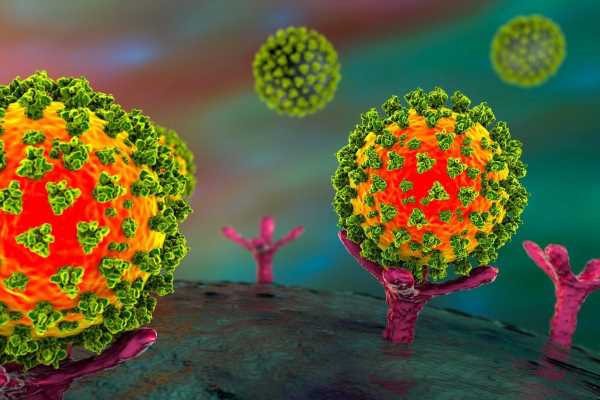Researchers in the United States have shown the inhalation of an angiotensin-converting enzyme 2 (ACE2) decoy receptor, sACE22.v2.4-IgG1, increases survival and ameliorates lung injury in K18-hACE2 transgenic mice infected with a lethal dose of the virulent severe acute respiratory syndrome coronavirus 2 (SARS-CoV-2) gamma variant.
Moreover, the engineered decoy binds tightly to spike (S) of BA.1 and BA.2 omicron, despite omicron bearing extensive mutations, and the binding also outperforms the four monoclonal antibodies approved for clinical use.

The study also demonstrates that besides the tight-binding ability against the divergent S proteins of SARS-CoV-2, the ACE2’s catalytic activity also contributes to the therapeutic efficacy of the decoy.
A pre-print version of the research paper is available on the bioRxiv* server while the article undergoes peer review.
Background
Effective therapeutic options for coronavirus disease 2019 (COVID-19) are continuously needed, especially as the immunity wanes and new SARS-CoV-2 variants with the potential for immune escape emerge.
The U.S. Food and Drug Administration (FDA) has granted emergency use authorization (EUA) to six monoclonal antibodies for treating mild-to-moderate COVID-19: casirivimab, imdevimab, bamlanivimab, etesevimab, sotrovimab, and bebtelovimab. Two more antibodies, tixagevimab and cilgavimab, are authorized for prophylactic use in immunocompromised patients.
These antibodies neutralize infection by targeting the receptor-binding domain (RBD) of the SARS-CoV-2 S protein, which functions in binding the human receptor-ACE2 for cell entry. However, the genomic sequence of RBD is poorly conserved across the SARS-related betacoronaviruses, as well as the emerging SARS-CoV-2 variants, which results in resistance to monoclonal antibody treatment.
Omicron far exceeds other variants of concern (VOCs) in its number of mutations, with 15 and 16 mutations, respectively in the RBD alone, resulting in extensive changes to the antigenic epitopes which markedly reduce the efficacy of antibodies. Studies have shown that Omicron can escape most of the therapeutic and prophylactic antibodies, except LY-CoV1404. Therefore, the question arises whether monoclonal antibodies are suitable over the long term for the treatment of endemic COVID-19.
An alternative treatment approach is to use the soluble ACE2 decoy receptors that bind and block the RBD. The extracellular domain of ACE2 can be expressed as a soluble protein -sACE2- that blocks the RBD. Next-generation sACE2 decoys have been engineered for exceptionally tight affinity to the S protein (KD < 1 nM) of genetically diverse SARS-CoV-2 variants. Reports have shown potent neutralization against BA.1 omicron for some engineered decoys, but activity against BA.2 omicron has yet to be established.
The study
The engineered decoy sACE22.v2.4-IgG1 carries three substitutions in its sequence compared to the wild-type ACE2, which enhances its affinity for the S protein. At the same time, fusion to the Fc part of IgG1 increases serum stability for sustained virus clearance.
The team had previously demonstrated mitigation of lung vascular endothelial injury and prolonged survival of SARS-CoV-2 infected mice by intravenous (IV) administration of sACE22.v2.4-IgG1 decoy. To further characterize the potential of sACE22.v2.4-IgG1, the team in the current study tested the decoy via an inhalation route (aerosolized by a nebulizer) in mice inoculated with a lethal dose of virulent SARS-CoV-2 gamma variant.
Compared with the control group mice, all of which died at 6-7 days with a 30% weight loss, the treatment group on sACE22.v2.4-IgG1 decoy demonstrated survival rates of 20% of the mice. Weight loss was relatively lower in this group (5%-15%) and the remaining 80% of mice died in 8-10 days, indicating prolonged survival.
Expression studies (via qPCR) demonstrated that the decoy inhalation significantly inhibited viral replication. Cytokine release and immune cell infiltration were also reduced in the lungs, in comparison to the control group. Based on these observations, the team suggests that sACE22.v2.4-IgG1 inhalation efficiently alleviates severe lung injury and increases survival following a lethal dose of SARS-CoV-2 gamma variant infection.
Inhalation may be the first-line treatment in outpatients with early infection, whereas IV delivery could be reserved for hospitalized patients in which the virus has spread beyond the lungs”, suggests the team.
To probe any potential role of proteolytic activity of a sACE2 decoy in the mechanism of treatment, the team introduced two mutations (NN) in the decoy’s active site to disrupt the catalytic activity. The team found catalytically inactive sACE22.v2.4(NN)-IgG1 failed to cleave a substrate peptide, whereas the protein’s affinity for RBD was unchanged.
The team further tested the mutated decoy on SARS-CoV-2 infected mice and found that the mice that inhaled catalytically inactive sACE22.v2.4(NN)-IgG1 lost more body weight than mice that inhaled catalytically active sACE22.v2.4-IgG1.
Also, compared to the catalytically inactive sACE22.v2.4(NN)-IgG1 that prolonged survival with a 10% survival rate, the catalytically active sACE22.v2.4-IgG1 extended survival further by 1 day longer with a 20% survival rate. These findings support the hypothesis that ACE2 catalytic activity contributes to therapeutic efficacy.
We show here that catalytically inactivated sACE22.v2.4(NN)-IgG1 is not as effective at prolonging survival of hACE2 transgenic mice infected with a lethal virus dose, suggesting that the catalytic activity of ACE2 present in the decoy confers additional therapeutic benefits”, highlights the team.
Discussion and conclusion
Flow cytometric analysis showed that when compared to the wild type sACE2, the engineered decoy sACE2.v2.4 binds more tightly to the cells expressing S protein of BA.1 and BA.2 omicron subvariants respectively.
On comparing the binding of the engineered decoy to cells expressing S protein of BA.1 omicron with four monoclonal antibodies, the team found that while the decoy receptor bound at low nanomolar concentrations, and three (casirivimab, imdevimab, or bamlanivimab) out of four antibodies did not bind substantially to the BA.1 omicron S, only sotrovimab demonstrated binding, nevertheless with less strength than the engineered decoy. Furthermore, the binding of sACE22.v2.4-IgG1 to BA.2 omicron S expressing cells also outperformed the binding of four monoclonal antibodies.
Later the team tested the neutralization of BA.1 omicron virus, by the engineered decoy, and concluded that sACE22.v2.4-IgG1 was exceptionally effective at neutralizing BA.1 omicron when compared to wild type sACE22-IgG1.
We show here that decoy receptors remain highly potent against both omicron variants and based on their similarity to the native ACE2 receptor, decoys will likely remain effective against future variants as SARS-CoV-2 evolves”, the team concludes.
*Important notice
bioRxiv publishes preliminary scientific reports that are not peer-reviewed and, therefore, should not be regarded as conclusive, guide clinical practice/health-related behavior, or treated as established information.
- Zhang L, Narayanan KK, Cooper L et al. (2022). An engineered ACE2 decoy receptor can be administered by inhalation and potently targets the BA.1 and BA.2 omicron variants of SARS-CoV-2. bioRxiv. doi: https://doi.org/10.1101/2022.03.28.486075, https://www.biorxiv.org/content/10.1101/2022.03.28.486075v1
Posted in: Medical Science News | Medical Condition News | Disease/Infection News
Tags: ACE2, Angiotensin, Angiotensin-Converting Enzyme 2, Antibodies, Antibody, Cell, Coronavirus, Coronavirus Disease COVID-19, covid-19, Cytokine, Cytometric Analysis, Efficacy, Enzyme, Food, Genomic, immunity, Lungs, Monoclonal Antibody, Next Generation, Omicron, Protein, Receptor, Research, Respiratory, SARS, SARS-CoV-2, Severe Acute Respiratory, Severe Acute Respiratory Syndrome, Sotrovimab, Syndrome, Transgenic, Vascular, Virus, Weight Loss

Written by
Namita Mitra
After earning a bachelor’s degree in Veterinary Sciences and Animal Health (BVSc) in 2013, Namita went on to pursue a Master of Veterinary Microbiology from GADVASU, India. Her Master’s research on the molecular and histopathological diagnosis of avian oncogenic viruses in poultry brought her two national awards. In 2013, she was conferred a doctoral degree in Animal Biotechnology that concluded with her research findings on expression profiling of apoptosis-associated genes in canine mammary tumors. Right after her graduation, Namita worked as Assistant Professor of Animal Biotechnology and taught the courses of Animal Cell Culture, Animal Genetic Engineering, and Molecular Immunology.
Source: Read Full Article
